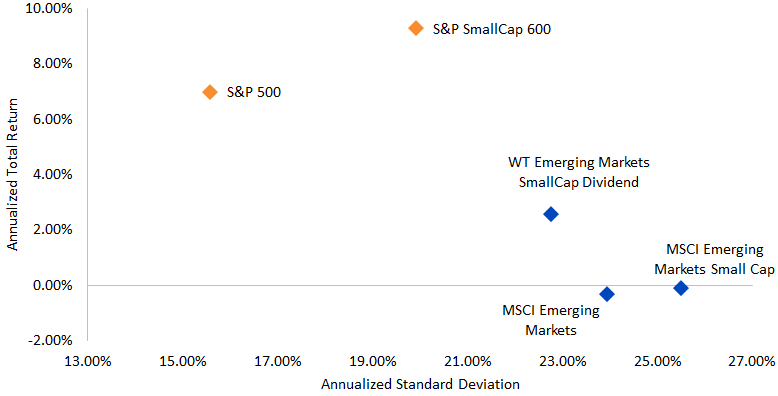
Most investors have heard of the “size premium,” the well-documented and academically studied tendency for small-cap companies to outperform large-cap companies over time, but with additional risk. For example, we can see this phenomenon in the table below. The S&P SmallCap 600 Index outperformed the S&P 500 Index by 229 basis points (bps) annualized over 9.5 years,1 but did so while increasing standard deviation by over 4 percentage points relative to the S&P 500.2
But what if it were possible to capture the size premium with volatility similar to large caps while also helping to complete balanced, globally diversified exposure? Well, in the emerging market (EM) space, it has been possible. Though the relative outperformance is less pronounced than in the U.S., over the last 9.5 years, the MSCI Emerging Markets Small Cap Index was able to outperform the MSCI Emerging Markets Index while increasing annualized volatility by just 1.6 percentage points.3 This was a much narrower spread in volatility than was seen when moving down the size spectrum in the U.S., but it did maintain the relationship between large- and small-cap risk, nonetheless.
Index Risk and Return, 8/1/07–12/31/16
For definitions of indexes in the chart, visit our glossary.
Less Volatility While Maintaining Excess Returns
The question then becomes, what if one differentiated EM small-cap exposure, aiming to gain superior risk-adjusted returns relative to cap-weighting? Could it then be possible for EM small caps to have even less volatility than cap-weighted large caps while maintaining excess returns?
WisdomTree achieved this counterintuitive conclusion over the same 9.5 years previously observed, beginning when it launched the WisdomTree Emerging Markets SmallCap Dividend Index. This small-cap Index has managed to outperform both cap-weighted large- and small-cap indexes by an average of over 250 bps per year while actually reducing annualized volatility relative to cap-weighted EM large caps by more than a percentage point.4 A small-cap index outperforming a large-cap index with less risk may be hard to believe, but we think it all starts with intuitive, intelligent and simple design.


















